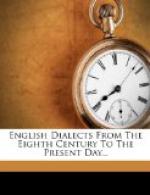“the facts are still far from being generally known, and I have repeatedly been amused, on reading passages from Cursor Mundi and Hampole to men of education, both English and Scotch, to hear them all pronounce the dialect ‘Old Scotch.’ Great has been the surprise of the latter especially on being told that Richard the Hermit [i.e. of Hampole] wrote in the extreme south of Yorkshire, within a few miles of a locality so thoroughly English as Sherwood Forest, with its memories of Robin Hood. Such is the difficulty which people have in separating the natural and ethnological relations in which national names originate from the accidental values which they acquire through political complications and the fortunes of crowns and dynasties, that oftener than once the protest has been made— ‘Then he must have been a Scotchman settled there!’”
The retort is obvious enough, that Barbour and Henry the Minstrel and Dunbar and Lyndesay have all recorded that their native language was “Inglis” or “Inglisch”; and it is interesting to note that, having regard to the pronunciation, they seem to have known, better than we do, how that name ought to be spelt.
CHAPTER V
NORTHUMBRIAN IN THE FIFTEENTH CENTURY
The subject of the last chapter was one of great importance. When it is once understood that, down to 1400 or a little later, the men of the Scottish Lowlands and the men of the northern part of England spoke not only the same language, but the same dialect of that language, it becomes easy to explain what happened afterwards.
There was, nevertheless, one profound difference between the circumstances of the language spoken to the north of the Tweed and that spoken to the south of it. In Scotland, the Northumbrian dialect was spoken by all but the Celts, without much variety; the minor differences need not be here considered. And this dialect, called Inglis (as we have seen) by the Lowlanders themselves, had no rival, as the difference between it and the Erse or Gaelic was obvious and immutable.
To the South of the Tweed, the case was different. England already possessed three dialects at least, viz. Northumbrian, Mercian, and Saxon, i.e. Northern, Midland, and Southern; besides which, Midland had at the least two main varieties, viz. Eastern and Western. Between all these there was a long contention for supremacy. In very early days, the Northern took the lead, but its literature was practically destroyed by the Danes, and it never afterwards attained to anything higher than a second place. From the time of Alfred, the standard language of literature was the Southern, and it kept the lead till long after the Conquest, well down to 1200 and even later, as will be explained hereafter. But the Midland dialect, which is not without witness to its value in the ninth century, began in the thirteenth




